
Hiking Dude Blog
2024 - Nov Sep Aug Jul Jan
2023 2022 2021 2020 2019 2018 2017 2016 2015 2014 2013 2012 2011
06/27/2016
Northern MN Hike
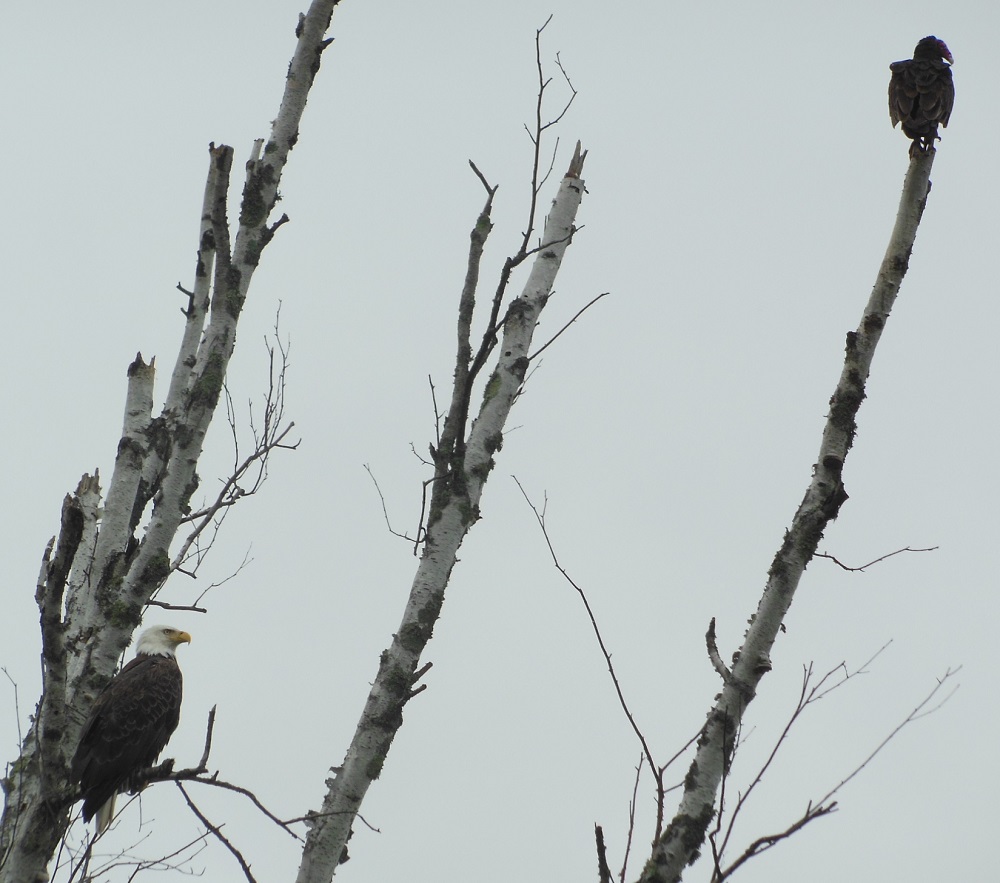
 I returned from a week in Texas on Saturday night and headed back on the road on Sunday morning for northern Minnesota. First week was volunteering at a "Camp Noah" project, but this week is just vacation.
I returned from a week in Texas on Saturday night and headed back on the road on Sunday morning for northern Minnesota. First week was volunteering at a "Camp Noah" project, but this week is just vacation.Today, I got to hike a new trail at Echo Lake in the Superior National Forest. I explored the trail with two brothers-in-law (any way two guys that each married a different sister of my wife - I think that makes them my brothers-in-law), and we were out for about 90 minutes doing a 5 mile loop route.
This eagle was in a tree along with about a dozen vultures, so I'm not sure if he thought he was a vulture also or what. Other than this, we saw only rabbits on the road and a bit of Moose sign on the trail.
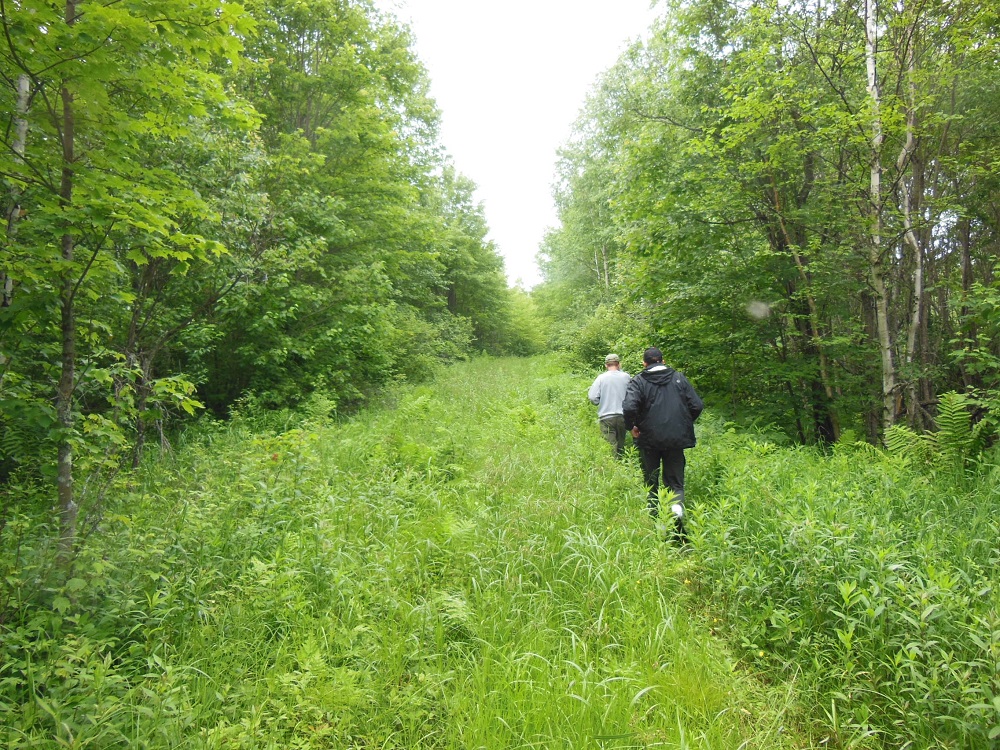
 The trail follows an old logging road for the first 2 miles with cut-offs for shorter loops along the way. Each cut-off was heavily overgrown and blocked with down trees, so we kept on. When we reached the outermost loop, it was thick, soupy marsh and very overgrown so we backtracked to the next loop path.
The trail follows an old logging road for the first 2 miles with cut-offs for shorter loops along the way. Each cut-off was heavily overgrown and blocked with down trees, so we kept on. When we reached the outermost loop, it was thick, soupy marsh and very overgrown so we backtracked to the next loop path.We plowed ahead through prime TICK country all the while being accompanied by small clouds of mosquitoes. The Deep Woods Off repellent worked just fine and I got no bites.
There were thousands of wild flowers, lush grass, and many birch, pines, and poplar trees. We ran into lots of small blueberry bushes and wild strawberry plants but it's too early for fruit yet.

 Most of the trail was dry, but we eventually encountered impassable water and were forced to slosh through, everyone getting their feet wet.
Most of the trail was dry, but we eventually encountered impassable water and were forced to slosh through, everyone getting their feet wet.Back at the trailhead, we checked for ticks. We each found about a half dozen. All mine were on my socks, into which I had tucked my pant legs. Absolutely no ticks on my pants or shirt - both have been treated with permethrin!
So, a fun, short, wild hike on a seldom used trail.
07/22/2016
C 2 C - By Bike

 Well, tomorrow his wheel hits the Pacific!
Well, tomorrow his wheel hits the Pacific! My Eagle Scout son completes his Atlantic to Pacific solo bicycle ride from Boston, MA to Anacortes, WA. It has been fun following his progress from sea to sea, covering over 3800 miles, on his blog at BikingDude.com This is his starting photo and I look forward to seeing its twin posted soon.
I now understand a bit more how family back home feel when I'm out hiking for a month. It was a bit stressing when he didn't blog a few days after getting used to seeing his report each day. We were helpless to assist when he had mechanical problems. I could only imagine how much work it took to climb mountain passes, how hot it was across the prairie, and how close traffic came on narrow shoulders. It's a lot easier being the one out there doing the thing than it is being home.
The most enjoyable part for me was to hear how he met many friendly, helpful people just as I often do on my long hikes. A long excursion makes the world a bit smaller and shows that there is certainly a lot more good out there than we usually hear about.
He still has more road to ride. He plans to bike down to San Francisco to visit friends and then see what's next. You'll have to check out his blog to see what happens.
My next (much smaller) adventure starts tomorrow. I'll be leading a group backpacking in the Cloud Peak Wilderness of Wyoming for just a week. It is forecast to be a super week with great weather, fishing, hiking, mountains, wildlife, and as a special treat - my wife will be on the trek. She's not been backpacking in many years, so my fingers are crossed that she'll catch the bug to go on more adventures.
Leave Comment
Posted: 07/22/2016
Posted: 07/22/2016
07/24/2016
Into The Mountains
 Heading into the mountains of Wyoming for a week of backpacking this afternoon. This is our campsite in Buffalo last night with the Bighorns in the background. A forest fire on the west side made us change route but weather should be great, so it's all good.
Heading into the mountains of Wyoming for a week of backpacking this afternoon. This is our campsite in Buffalo last night with the Bighorns in the background. A forest fire on the west side made us change route but weather should be great, so it's all good. Leave Comment
Posted: 07/24/2016
Posted: 07/24/2016
Day 1 - Triangle Park
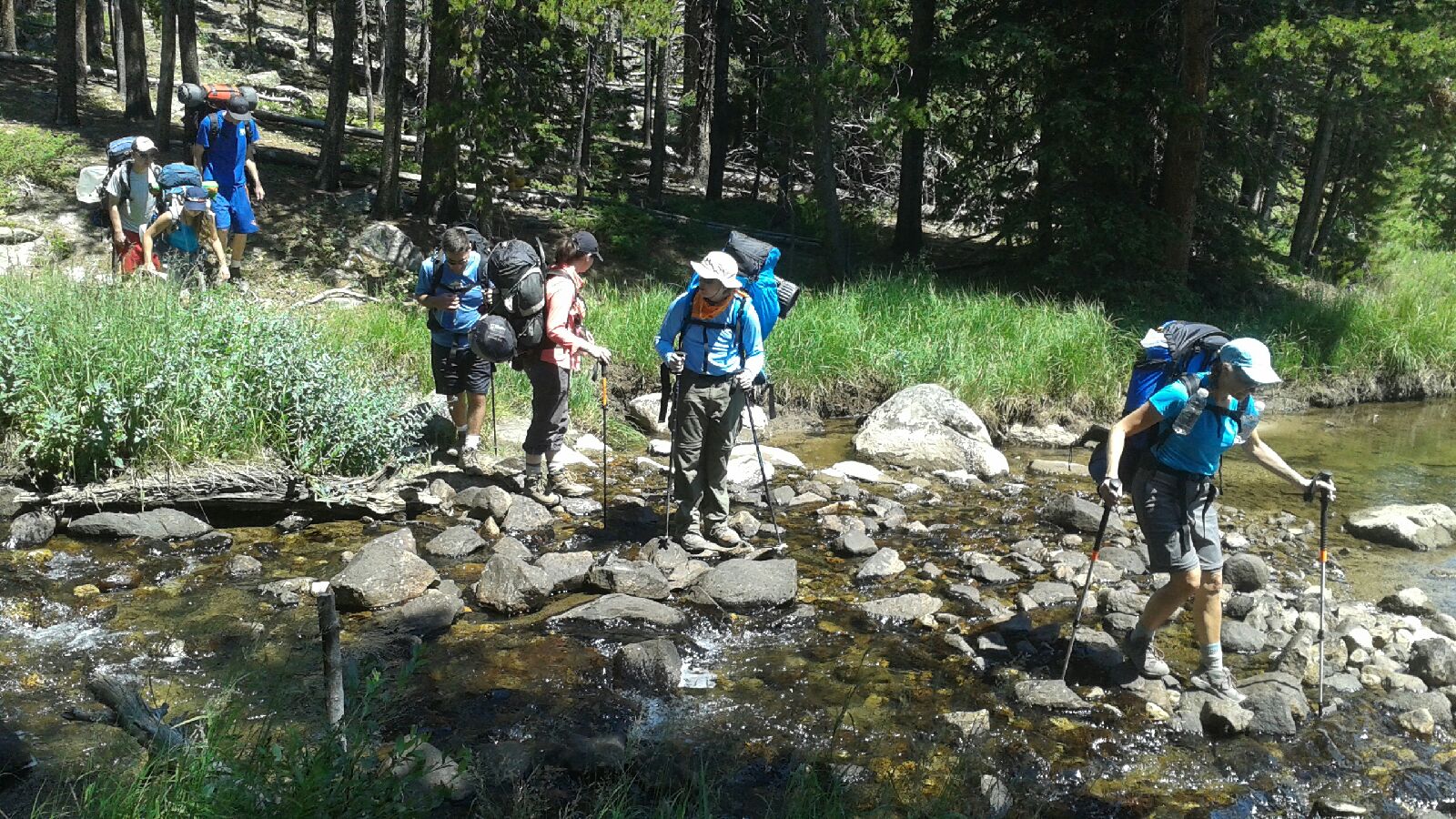 Our first day of hiking and camping was a great opportunity to get a rhythm going. We only covered about 3.5 miles from Hunter trailhead to Triangle Park, but we had a couple water crossings, tough trail, and dust. The crew found a very nice campsite secluded just in the trees with a nice view across the meadow. It's really hard to see that we are here.
Our first day of hiking and camping was a great opportunity to get a rhythm going. We only covered about 3.5 miles from Hunter trailhead to Triangle Park, but we had a couple water crossings, tough trail, and dust. The crew found a very nice campsite secluded just in the trees with a nice view across the meadow. It's really hard to see that we are here. Our first dinner and clean up could have gone better but it tasted great and Mrs. Dude and I did the dishes. That's Mrs. Dude crossing the stream, too.
Just a gorgeous day with a few puffy clouds, nice breeze, no humidity, and few mosquitoes this evening. A couple guys fished in a tiny creek. One guy helped fix my fly pole. :-)
Didn't see any animals except horse.
Early to bed and the temp is dropping so we should sleep well.
07/25/2016
Day 2 - Elk Lake
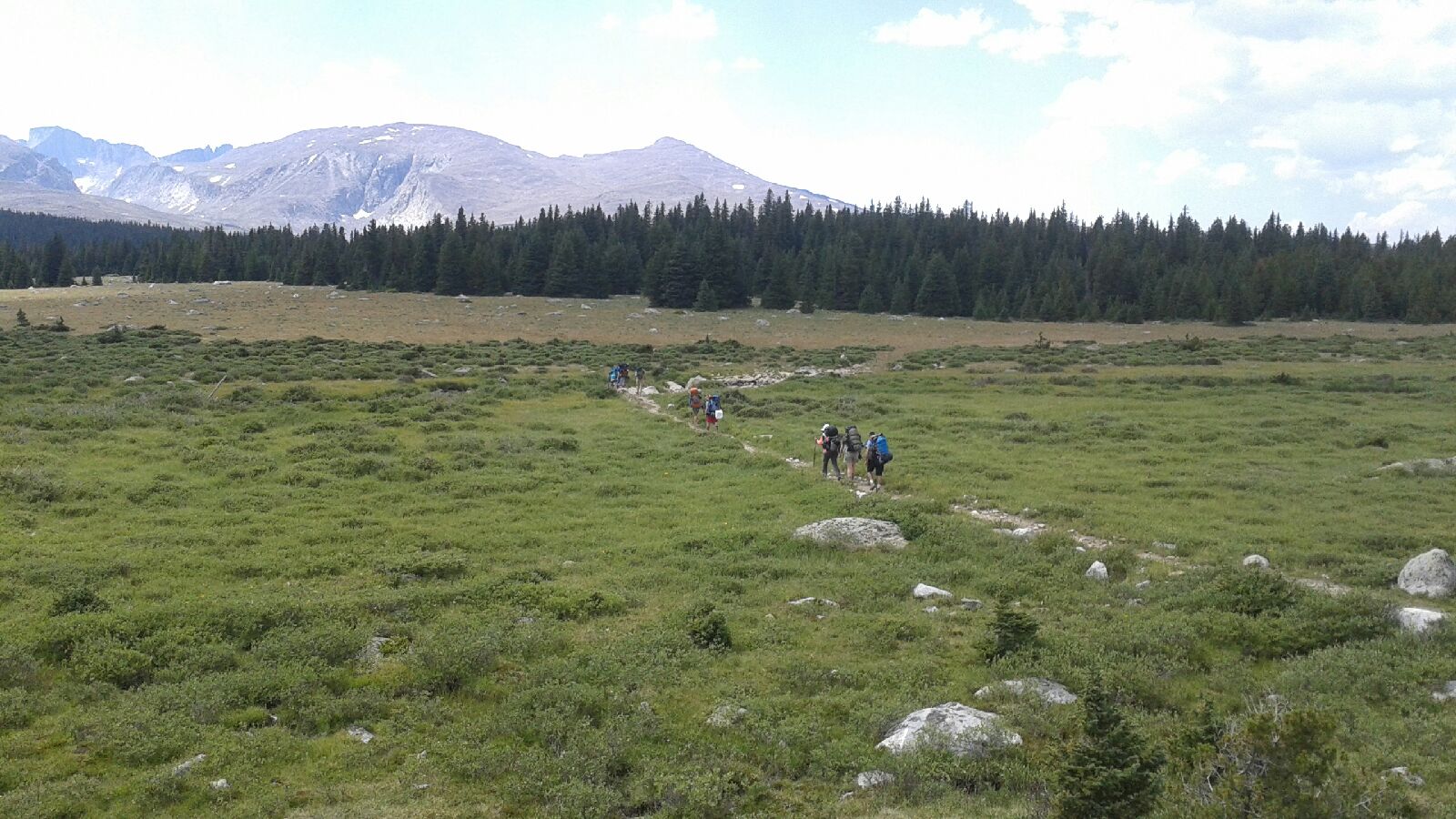 Our second day was great. I saw a couple elk near our campsite when I woke up. But before that I enjoyed a wonderful view of the big dipper over the mountains when I had to get up at 1:30am.
Our second day was great. I saw a couple elk near our campsite when I woke up. But before that I enjoyed a wonderful view of the big dipper over the mountains when I had to get up at 1:30am.We got on the trail at 9:30 and had a few miles of pretty tough uphill to a beautiful lunch spot on the top of a pass. From there, it was a rocky but easy walk down to Elk Lake where we eventually found a decent spot to camp.
We saw moose in the lake and a herd of elk run by. The rocky mountains make for a wonderful backdrop across the lake.
Mac and cheese for dinner, but the chili ramen was spicy.
There was frost on the grass this morning but tonight seems much warmer even though we are 1000 feet higher at 9800 feet.
07/26/2016
Day 3 - Rest Day
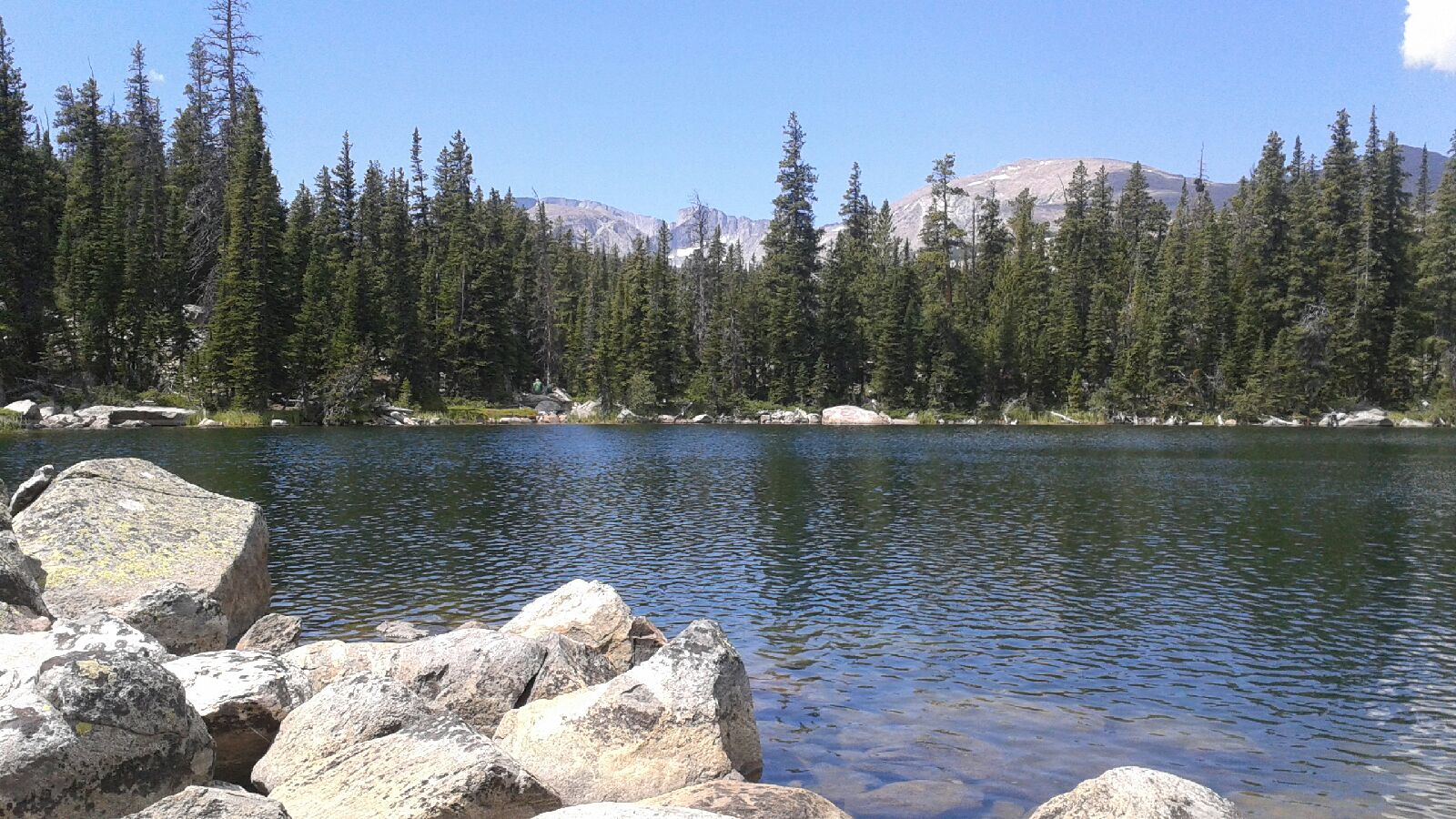 It managed to drop below freezing last night and get frost again. We're camping at the same spot tonight so there was no required hiking. One group hiked up a ridge for the views and I hiked to another valley for some fishing.
It managed to drop below freezing last night and get frost again. We're camping at the same spot tonight so there was no required hiking. One group hiked up a ridge for the views and I hiked to another valley for some fishing. We hiked 1.5 miles to a mountain reservoir full of trout. We lost count of the fish we caught on flies and spinners over the 6 hours we fished. Mostly brook trout, but a few rainbows and cutthroat, too.
The group decided on an early dinner since storm clouds were building and rolling past. We never did get any rain, but it was nice to eat early.
Tonight, the mosquitos were pretty bad. We saw a fisher exploring our camp and a moose across the lake.
07/27/2016
Day 4 - Over Ant Hill
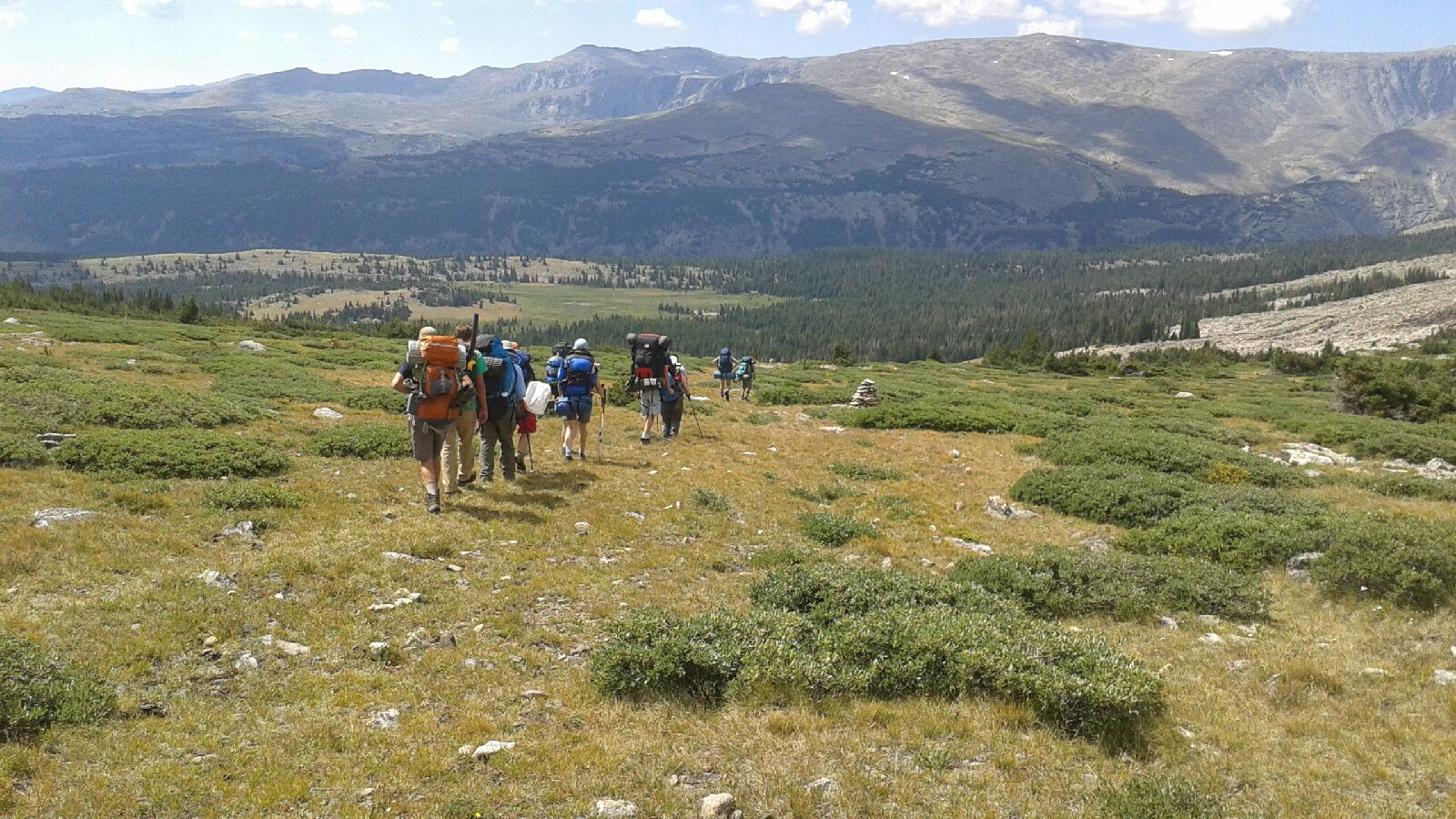 Our intrepid crew hiked from Elk Lake over a 10600 foot saddle behind Ant Hill then across a creek and up a hillside to the Seven Brothers area. This was our longest hiking day with the most elevation.
On the trail, we passed both of our other groups going the other direction.
Our new home is a VERY impacted site since this area gets heavy use.
We had horrendous lightning last night.
Our intrepid crew hiked from Elk Lake over a 10600 foot saddle behind Ant Hill then across a creek and up a hillside to the Seven Brothers area. This was our longest hiking day with the most elevation.
On the trail, we passed both of our other groups going the other direction.
Our new home is a VERY impacted site since this area gets heavy use.
We had horrendous lightning last night.
07/28/2016
Day 5 - Seven Brothers
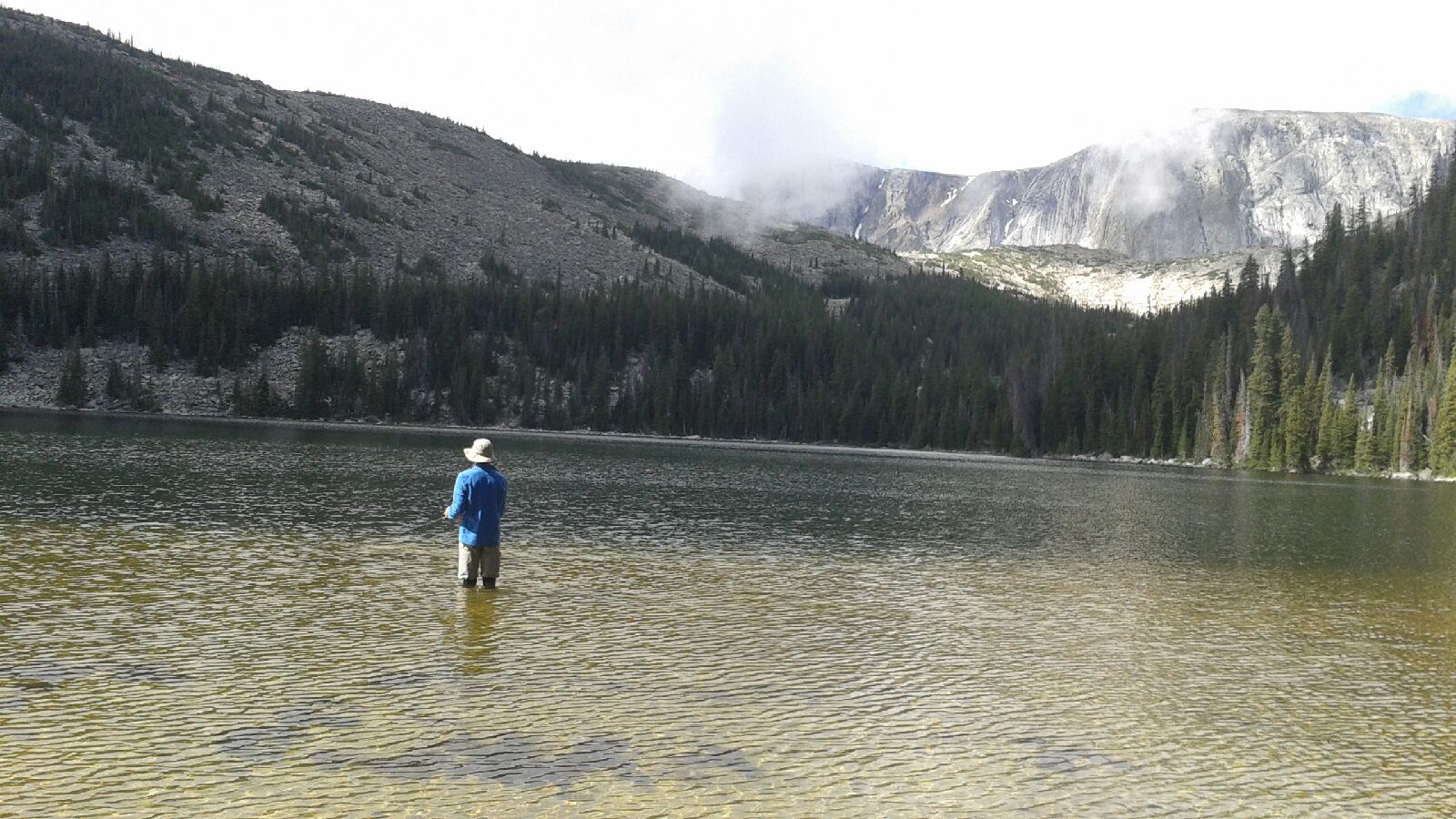 We spent the morning fishing after another night of intense lightning and rain. The fish were off and we caught very few but the scenery was terrific.
We packed up in the afternoon and hiked out to Soldier Park for our last night in the wild. It was a nice hike since it was almost all downhill.
We left the official wilderness after our water crossing and then camped at a very overused spot. It was a strong contrast with the more beautiful wilderness settings.
We spent the morning fishing after another night of intense lightning and rain. The fish were off and we caught very few but the scenery was terrific.
We packed up in the afternoon and hiked out to Soldier Park for our last night in the wild. It was a nice hike since it was almost all downhill.
We left the official wilderness after our water crossing and then camped at a very overused spot. It was a strong contrast with the more beautiful wilderness settings.
07/31/2016
Day 6 - Out of the Mountains
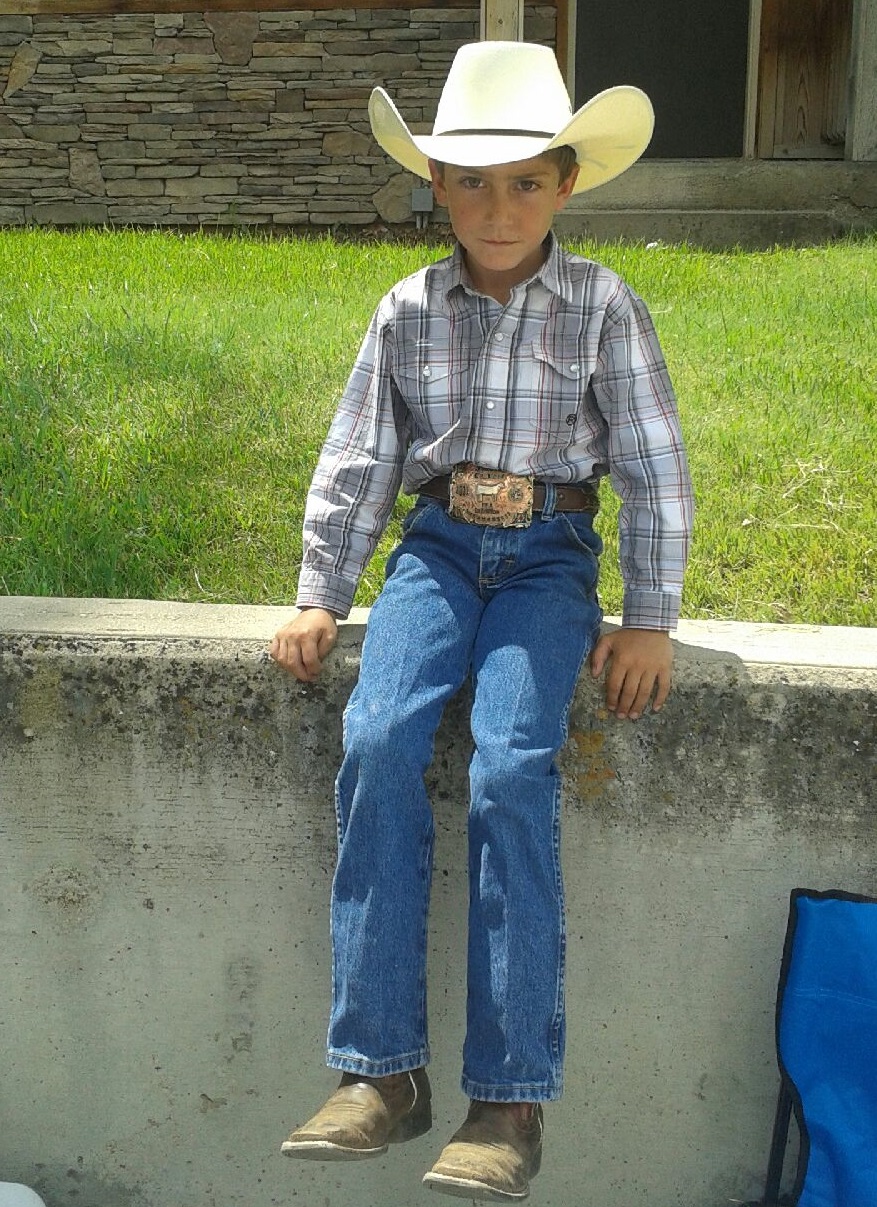 A short, brisk hike down the mountain and we were back in civilization, taking showers in Buffalo, WY. We had the afternoon to explore the small town that just happened to be holding its 'Crazy Days' event - basically a sidewalk sale. My highlight was meeting this real, live, Wyoming cowboy selling lemonade with his little brother!
A short, brisk hike down the mountain and we were back in civilization, taking showers in Buffalo, WY. We had the afternoon to explore the small town that just happened to be holding its 'Crazy Days' event - basically a sidewalk sale. My highlight was meeting this real, live, Wyoming cowboy selling lemonade with his little brother! It was a super week with great weather having storms only at night, fun people, plenty of wildlife, and majestic views.
Leave Comment
Posted: 07/31/2016
Posted: 07/31/2016
08/04/2016
Hot Ash Review
So, what's your favorite kind of cooking fuel out in the wilds - wood, alcohol, canister, white gas, fuel tabs, or something else? They all have pros and cons, including efficiency, cleanliness, smoke, carry weight, speed, cost, and impact. I've used them all and am always interested in new options that come along.
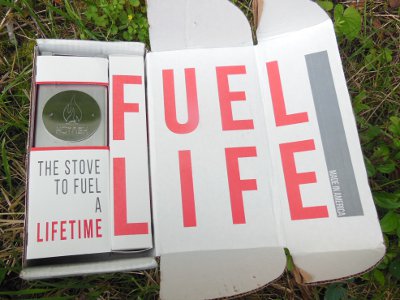

The Hot Ash stove came out last year and it's a new entry in the general wood-burning "rocket stove" category. While an open fire tends to be inefficient, slow, and smokey, a rocket stove harnesses the fuel's potential and converts more of it into usable heat. Small twigs are the fuel and a well-designed combustion area creates big heat. Feel free to google "rocket stove design" to find out how they are being used in kitchens, as home heaters, and for outdoor cooking.
The folks at Hot Ash asked me to give their stove a try and let you all know what I thought of it. They provided me with a stove to test. So, the other day, I took a bag on my morning hike and picked up a bunch of twigs and sticks from the trail to burn. Then, I took the stove and sticks to a secluded area of the local park and got busy. Here's what I found out...


The Hot Ash is a sturdy, thick metal, hot burning, wood fueled camping stove. The design allows it to be disassembled and packed into a 3x3x9 inch box shape (that's about the size of a 16oz. jar of Planter's dry roasted peanuts). That's a pretty small and portable size. It comes in cool packaging with simple instructions and a cloth bag to carry the stove in to keep your other gear clean. The stove is completely stainless steel - and it's thick steel, too. It will withstand pretty much any abuse you want to throw at it, or throw it at. I even pounded it on some rocks a few times and the metal just scratched a bit, no dents.
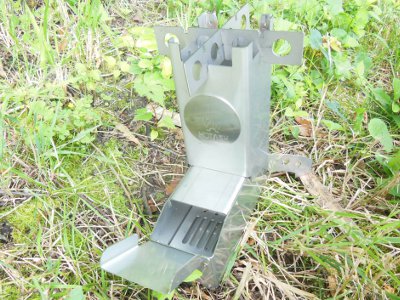

I set up the stove by placing the pieces together and using two thumbscrews to hold on stabilizing feet and fuel chamber. It's very stable and low enough to the ground that there's not much danger of burns from spilled hot liquids. I think one design improvement could be to replace the thumbscrews with a sliding lock, something like a keyhole, so there are no small, loose screws. Other than that, assembly is easy and fast.
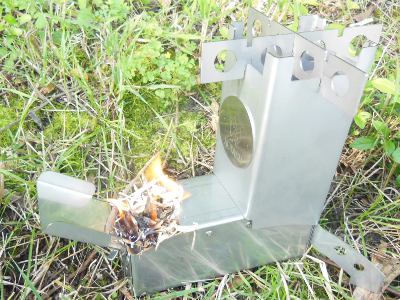

I shaved a few sticks for tinder and shoved the small bits of wood into the horizontal fuel chamber. The fuel chamber is above an elevated air chamber that pulls air in for efficient combustion, the key to a rocket stove design. My dry tinder lit easily and the twigs were burning in less than a minute.
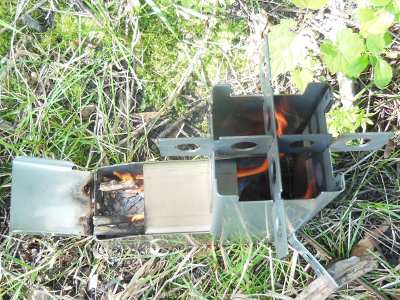

One of the key benefits of a rocket stove is that it burns hot and with very little smoke. It took about 6 minutes from lighting to smokeless, hot fire. Once the air draw was going strong and the heat was roaring up the chimney, the stove burned hot and clean. With the fuel chamber full of small sticks, I let the stove burn to see how long it would last. With no additional fuel, it burned for about 10 minutes and took another 15 minutes to burn to ash and become cool enough to touch the support legs to move the stove.
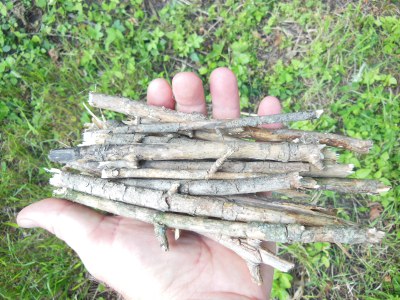

Ten minutes is plenty of time to boil a pint of water. Using just a small handful of twigs, a quick meal can be prepared. For longer heat, it's easy to feed more fuel into the chamber as it burns down.
I had fun playing with the Hot Ash, and I expect it will be a useful stove for many campers. Like any piece of equipment, it must be compared to alternative items that perform the same task, and individuals need to determine how they plan to use it.
Pros
Cons
Who Would Use It?
Hike On


The Hot Ash stove came out last year and it's a new entry in the general wood-burning "rocket stove" category. While an open fire tends to be inefficient, slow, and smokey, a rocket stove harnesses the fuel's potential and converts more of it into usable heat. Small twigs are the fuel and a well-designed combustion area creates big heat. Feel free to google "rocket stove design" to find out how they are being used in kitchens, as home heaters, and for outdoor cooking.
The folks at Hot Ash asked me to give their stove a try and let you all know what I thought of it. They provided me with a stove to test. So, the other day, I took a bag on my morning hike and picked up a bunch of twigs and sticks from the trail to burn. Then, I took the stove and sticks to a secluded area of the local park and got busy. Here's what I found out...


The Hot Ash is a sturdy, thick metal, hot burning, wood fueled camping stove. The design allows it to be disassembled and packed into a 3x3x9 inch box shape (that's about the size of a 16oz. jar of Planter's dry roasted peanuts). That's a pretty small and portable size. It comes in cool packaging with simple instructions and a cloth bag to carry the stove in to keep your other gear clean. The stove is completely stainless steel - and it's thick steel, too. It will withstand pretty much any abuse you want to throw at it, or throw it at. I even pounded it on some rocks a few times and the metal just scratched a bit, no dents.


I set up the stove by placing the pieces together and using two thumbscrews to hold on stabilizing feet and fuel chamber. It's very stable and low enough to the ground that there's not much danger of burns from spilled hot liquids. I think one design improvement could be to replace the thumbscrews with a sliding lock, something like a keyhole, so there are no small, loose screws. Other than that, assembly is easy and fast.


I shaved a few sticks for tinder and shoved the small bits of wood into the horizontal fuel chamber. The fuel chamber is above an elevated air chamber that pulls air in for efficient combustion, the key to a rocket stove design. My dry tinder lit easily and the twigs were burning in less than a minute.


One of the key benefits of a rocket stove is that it burns hot and with very little smoke. It took about 6 minutes from lighting to smokeless, hot fire. Once the air draw was going strong and the heat was roaring up the chimney, the stove burned hot and clean. With the fuel chamber full of small sticks, I let the stove burn to see how long it would last. With no additional fuel, it burned for about 10 minutes and took another 15 minutes to burn to ash and become cool enough to touch the support legs to move the stove.


Ten minutes is plenty of time to boil a pint of water. Using just a small handful of twigs, a quick meal can be prepared. For longer heat, it's easy to feed more fuel into the chamber as it burns down.
I had fun playing with the Hot Ash, and I expect it will be a useful stove for many campers. Like any piece of equipment, it must be compared to alternative items that perform the same task, and individuals need to determine how they plan to use it.
Pros
- Fuel is free - it just burns wood, actually just twigs.
- Clean burning - once burning, it produces little smoke.
- Sturdy - it won't dent, deform, or break when dropped.
- Made in USA
- Compact - doesn't take much space when packed up.
- Fun - feeding small sticks into the fuel chamber is not a bad way to relax for a few minutes. The feel of real fire is something special, rather than the blue flame of gas.
Cons
- It weighs 3.1 pounds. You can save 1/2 pound by leaving the support legs and cross-pieces at home. This is heavy to take backpacking since an alcohol stove, canister stove, or even white gas stove with over a week's fuel is lighter. (I feel the stove is actually much stronger than needed - a lighter gauge steel on the chimney and chamber would work well and cut the weight.)
- It is not fast. Gathering fuel, building the fire, and then cooking, take much longer than other stoves, but faster than an open fire.
- Success is reliant on the environment. If there is no fuel, or it is wet, then you have no heat. If there are open fire bans in place, you can't use it.
- Cost - the purchase price is more expensive than many other cooking options.
Who Would Use It?
- Car Campers - setting up camp for a couple days. No fuel to carry, small space, and real flames make it a good solution when weight is no concern.
- Preppers - in case of emergency, it will be ready when a catastrophe hits. Just use scrap wood or debris for fuel.
- Dinosaur Lovers - someone trying to conserve fossil fuels and consume renewable carbon fuel will prefer this over a gas stove.
Hike On
Leave Comment
Posted: 08/04/2016
Posted: 08/04/2016
Older Posts Newer Posts
Find more Hiking Resources at www.HikingDude.com


Follow Me
Recent Comments